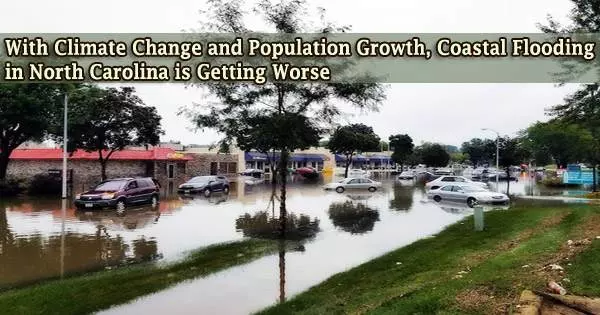Researchers are able to validate what data modeling algorithms have been forecasting regarding climate change thanks to a historical data set that is 120 years old: The frequency of precipitation events like hurricanes, tropical storms, and floods is rising due to climate change.
Tropical cyclone landfalls and rainfall linked with storms in Coastal North Carolina have been continuously recorded since 1898. According to the analysis, six of the seven precipitation events with the highest totals in that record have taken place in the past 20 years.
“North Carolina has one of the highest impact zones of tropical cyclones in the world, and we have these carefully kept records that shows us that the last 20 years of precipitation events have been off the charts,” said Hans Paerl, Kenan Professor of Marine and Environmental Sciences at the UNC-Chapel Hill Institute of Marine Sciences.
Paerl is lead author on the paper, “Recent increase in catastrophic tropical cyclone flooding in coastal North Carolina, USA: Long-term observations suggest a regime shift,” published July 23 in Nature Research’s Scientific Reports.
Hurricanes Floyd, Matthew, and Florence caused three storms in the last 20 years that resulted in very high floods. According to the analysis, there is a 2% chance that these three flooding incidents will occur in such a brief period of time.
This frequency suggests that “three extreme floods resulting from high rainfall tropical cyclone events in the past 20 years is a consequence of the increased moisture carrying capacity of tropical cyclones due to the warming climate,” the study said.
In addition to increasing the frequency of storms and floods, a growing world population is making matters worse by increasing greenhouse gas emissions, which in turn causes ocean temperatures to rise, evaporation to increase, and ultimately an increase in tropical cyclone-related precipitation.
We can help minimize the harmful effects of a ‘new normal’ of wetter storm events. Curbing losses of organic matter and nutrients by vegetative buffers around farmlands and developed areas prone to storm water runoff, minimizing development in floodplains and avoiding fertilizer applications during hurricane season, and reducing greenhouse gas emissions are positive steps which we can all contribute to.
Professor Hans Paerl
Increasing rainfall
Since the late 1990s, North Carolina has experienced a rise in previously unheard-of extreme rainfall. The study found that over the previous 120 years, the state has also experienced an increase in heavier rainfall caused by tropical storms.
“The price we’re paying is that we’re having to cope with increasing levels of catastrophic flooding,” Paerl said.
“Coastal watersheds are having to absorb more rain. Let’s go back to Hurricane Floyd in 1999, which flooded half of the coastal plain of North Carolina. Then, we had Hurricane Matthew in 2016. Just recently we had Hurricane Florence in 2018. These events are causing a huge amount of human suffering, economic and ecological damage.”
According to Paerl, a portion of such damage is caused by how frequently storms impact the coast. Because of this frequency, communities and ecosystems must struggle to recover and rebuild before the next storm strikes.
According to Paerl, the storms themselves don’t have to be powerful, severe hurricanes. Heavy rainfall from a Category 1 hurricane can result in significant property damage.
The increasing rainfall means more runoff going into estuarine and coastal waters, like the Neuse River Estuary, and downstream Pamlico Sound, the USA’s second largest estuarine complex and a key Southeast fisheries nursery.
More runoff results in greater losses of organic matter and nutrients through soil erosion, farming and animal husbandry, urban areas, and flushing of wetlands and swamps. Due to a rise in the amount of organic matter and nutrients, ecosystems will be overloaded and won’t be able to break them down rapidly enough to prevent severe algal blooms, hypoxia, and fish and shellfish mortality.
Increasing population
Additionally, North Carolina’s population is growing. The state has more than 10.3 million residents, according to 2018 U.S. Census data. In 1990, North Carolina had 6.6 million residents.
“We are in part responsible for what’s going on in the context of fossil fuel combustion emissions that are leading to global warming,” Paerl said. “The ocean is a huge reservoir that is absorbing heat and seeing more evaporation. With more evaporation comes more rainfall.”
Previous studies by Paerl’s group have demonstrated that tropical storms and periods of heavy rainfall increase the amount of organic material that is transported from the land to the ocean.
More carbon dioxide is produced and released back into the atmosphere during the processing and decomposition of those items by estuarine and coastal waters, which can increase the already rising carbon dioxide levels. After a storm has passed, these impacts could linger for several weeks to months.
“We can help minimize the harmful effects of a ‘new normal’ of wetter storm events,” Paerl said. “Curbing losses of organic matter and nutrients by vegetative buffers around farmlands and developed areas prone to storm water runoff, minimizing development in floodplains and avoiding fertilizer applications during hurricane season, and reducing greenhouse gas emissions are positive steps which we can all contribute to.”





